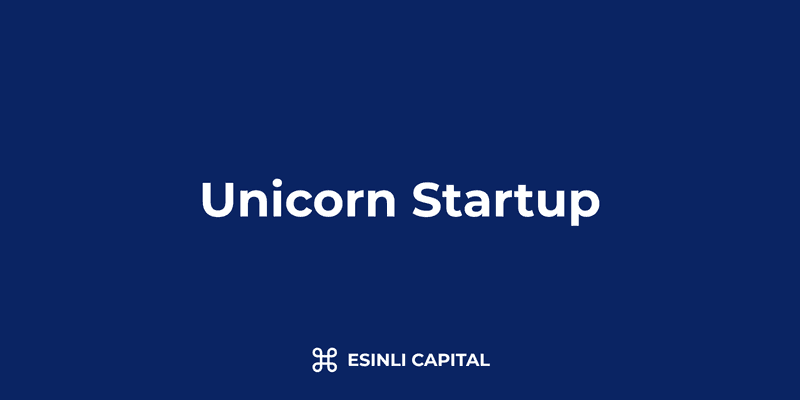In This Article
- What Makes a Company a Unicorn Startup?
- Unicorn Startups: The Path to Billion-Dollar Valuation
- Unicorn Startup Funding: Late-Stage Investing Dynamics
- Unicorn Exit Strategies and Investor Returns
- Are Unicorn Startups Worth Their Valuations?
- Unicorn Startup Characteristics: What Founders Need to Know
- The Future of Unicorn Startups and Market Disruption
- The Bottom Line
- What Makes a Company a Unicorn Startup?
- Unicorn Startups: The Path to Billion-Dollar Valuation
- Unicorn Startup Funding: Late-Stage Investing Dynamics
- Unicorn Exit Strategies and Investor Returns
- Are Unicorn Startups Worth Their Valuations?
- Unicorn Startup Characteristics: What Founders Need to Know
- The Future of Unicorn Startups and Market Disruption
- The Bottom Line

Unicorn Startups: Path to Billion-Dollar Valuation & Investment Implications
KEY TAKEAWAYS
- A unicorn startup is a privately-held company valued at $1 billion or more, named for the statistical rarity of such ventures
- The term was coined in 2013 by venture capitalist Aileen Lee, when only 39 such companies existed; today there are over 1,200 unicorns globally
- Unicorns typically share characteristics including disruptive technology, platform business models, and founder-led teams with strong execution capabilities
- Late-stage funding for unicorns often comes from non-traditional investors like sovereign wealth funds, corporate VCs, and private equity firms
- The rise of unicorns reflects structural market changes including longer private runways, larger available capital pools, and expanded global markets
What Makes a Company a Unicorn Startup?
A unicorn startup is a privately-held company that has reached a valuation of $1 billion or more. The term was first coined in 2013 by Aileen Lee, founder of Cowboy Ventures, in her article "Welcome to the Unicorn Club: Learning from Billion-Dollar Startups." At the time, such companies were exceedingly rare—just 39 existed when Lee published her analysis. Like their mythical namesake, these billion-dollar startups were considered almost magical in their scarcity and the transformative power they wielded in their respective markets.
Fast forward to 2025, and unicorns are significantly more common, though still representing a tiny fraction of all startups. According to CB Insights data, there are now over 1,200 unicorn companies globally, with a cumulative valuation exceeding $4 trillion. This expansion reflects fundamental changes in startup financing, technology adoption curves, and global market dynamics.
Unicorn Valuation Methodology
It's important to understand that a unicorn's billion-dollar status refers to its valuation, not its revenue or profit. This valuation is typically determined during funding rounds, where investors purchase equity at a price that implies the company's overall worth. The formula is relatively straightforward:
Company Valuation = Investment Amount ÷ Percentage of Equity Purchased
For example, if a venture capital firm invests $100 million for 10% equity in a startup, this implies a post-money valuation of $1 billion, qualifying it as a unicorn. These valuations aren't based on traditional metrics like price-to-earnings ratios, since many unicorns operate at a loss while prioritizing growth.
Instead, investors assess factors including:
- Total addressable market (TAM) size
- Revenue growth rate (often 100%+ annually)
- Unit economics and path to profitability
- Competitive moats and intellectual property
- Market leadership position
- Network effects and scaling potential
Notably, unicorn valuations are private determinations between companies and their investors—they aren't subject to the same market forces as public company valuations until they undergo an IPO or acquisition.
Unicorn Startups: The Path to Billion-Dollar Valuation
Reaching unicorn status typically follows a predictable funding progression, though the timeframe has compressed significantly over the years. The traditional path includes:
- Pre-seed/Seed stage: Initial funding from founders, friends and family, angels, and seed funds ($500K-$3M)
- Series A: Product-market fit validation ($5M-$15M)
- Series B: Scaling proven business model ($15M-$50M)
- Series C and beyond: Accelerating growth, often when unicorn status is achieved ($50M+)
While the average time to unicorn status was 7+ years before 2015, some companies now reach this milestone in less than two years. For instance, Miotech, an AI-based environmental, social, and governance (ESG) data provider, achieved unicorn status just 18 months after its founding.
Characteristics of Successful Unicorns
Research into unicorn companies reveals several common characteristics:
1. Disruptive Business Models The vast majority of unicorns introduce fundamentally different approaches to existing markets or create entirely new ones. These companies don't just improve on existing solutions—they reimagine the problem space entirely.
2. Platform Orientation Many unicorns operate platform business models that facilitate interactions between different user groups—think marketplaces, networks, or multi-sided platforms. These models benefit from network effects, where value increases exponentially as more users join, creating powerful competitive moats.
3. Technology-Driven While not all unicorns are technology companies in the traditional sense, virtually all leverage technology as a core differentiator. Advanced technologies like artificial intelligence, blockchain, and biotechnology have spawned numerous recent unicorns.
4. Consumer-Focused Innovation Though enterprise unicorns exist, many of the most notable unicorns began by addressing consumer pain points with intuitive, easy-to-adopt solutions that gradually expanded to other markets.
5. Founder-Led with Strong Execution Unicorns typically maintain founder leadership longer than average startups. These founding teams often combine domain expertise, technical brilliance, and exceptional execution ability—the "10x" teams that VCs seek.
6. Prioritization of Growth Over Profits Unicorns commonly operate at a loss as they prioritize market capture and revenue growth over immediate profitability, counting on economies of scale to eventually deliver margins.
Industry Distribution of Unicorn Startups
While the technology sector dominates unicorn creation, these companies span diverse industries. According to 2025 data, the distribution of unicorns by sector is:
-
Fintech (21%): Financial technology companies dominate the unicorn landscape, offering solutions from payment processing to digital banking and cryptocurrency.
-
Enterprise Software (17%): B2B software solutions, particularly SaaS platforms, represent a significant unicorn category.
-
E-commerce & Direct-to-Consumer (11%): Companies revolutionizing retail through online platforms and new distribution models.
-
Transportation & Logistics (8%): Mobility solutions, delivery platforms, and logistics optimization software.
-
Healthcare & Biotech (7%): Companies applying technology to healthcare delivery, drug discovery, and medical devices.
-
Artificial Intelligence (6%): Specialized AI applications across industries.
-
Cybersecurity (5%): Companies addressing the growing need for digital security.
-
Other (25%): Including edtech, proptech, agtech, cleantech, and other emerging sectors.
Regionally, while Silicon Valley still produces the most unicorns, their geographic distribution has broadened significantly. China, India, Europe (particularly the UK, Germany, and France), and emerging ecosystems like Brazil, Indonesia, and the United Arab Emirates are now regularly producing billion-dollar startups.
Unicorn Startup Funding: Late-Stage Investing Dynamics
The unicorn phenomenon has dramatically reshaped late-stage private investing. Traditional venture capital alone rarely provides the capital needed to reach and sustain unicorn status. Instead, these funding rounds now include diverse investor types:
Non-Traditional Unicorn Investors
-
Sovereign Wealth Funds: Government-owned investment vehicles like Saudi Arabia's Public Investment Fund (PIF), Singapore's GIC, and Abu Dhabi's Mubadala have become major unicorn backers, investing billions in late-stage rounds.
-
Corporate Venture Capital: Established companies like Google (via GV), Salesforce Ventures, and Intel Capital actively invest in unicorns, combining financial capital with strategic advantages.
-
Crossover Investors: Public market investors like Fidelity, T. Rowe Price, and Tiger Global increasingly participate in private rounds, bringing public market valuation discipline.
-
Private Equity Firms: Traditionally focused on mature businesses, firms like KKR, Blackstone, and TPG now have dedicated growth equity arms for unicorn investments.
-
Specialized Mega-Funds: Funds like SoftBank's Vision Fund, which raised $100 billion for its first fund, specifically target late-stage unicorns with investments often exceeding $100 million.
These investors typically seek different terms than early-stage VCs, including liquidation preferences, anti-dilution protection, and ratchets that protect their investment in down-round scenarios. This complexity has created "unicorn valuations with asterisks"—headline numbers that may not reflect the economic reality for all shareholders.
Unicorn Valuation Metrics
Late-stage investors evaluate unicorns using specialized metrics that differ from traditional financial analysis:
-
Rule of 40: For SaaS unicorns, the sum of growth rate and profit margin should exceed 40%.
-
LTV/CAC Ratio: Customer lifetime value divided by customer acquisition cost should exceed 3x for sustainable growth.
-
Burn Multiple: How much a company burns to generate each dollar of new ARR (Annual Recurring Revenue).
-
Efficiency Score: Revenue growth rate divided by net burn rate.
-
Gross Merchandise Value (GMV): Total sales value of goods or services sold through a marketplace platform.
Since many unicorns are unprofitable, revenue multiples become the primary valuation driver. In 2024-2025, typical revenue multiples for unicorns ranged from:
- 10-15x for enterprise SaaS companies
- 5-8x for marketplace platforms
- 4-6x for consumer subscription businesses
- 2-4x for hardware or capital-intensive businesses
These multiples fluctuate with market conditions, as seen during the 2021 valuation peak and subsequent 2022-2023 correction.
Unicorn Exit Strategies and Investor Returns
The ultimate test of a unicorn's valuation comes at exit, typically through:
-
Initial Public Offering (IPO): The traditional exit path, allowing investors to sell shares on public markets.
-
Direct Listing: An alternative public market entry where companies don't raise new capital but allow existing shareholders to sell.
-
Special Purpose Acquisition Company (SPAC): Merging with a shell company that's already public, bypassing the traditional IPO process.
-
Acquisition: Being purchased by a larger company, usually for strategic value.
-
Secondary Sales: Private transactions allowing early investors and employees to sell shares while the company remains private.
Historically, IPOs have been the dominant exit path for successful unicorns. However, exits have become more complex as companies stay private longer. The extended private runway has implications for both investors and employees:
- Early investors may wait 10+ years for liquidity
- Employee equity may have diminished value due to later-round terms
- Companies must navigate complex cap tables with diverse investor rights
For investors, unicorn returns follow power laws—a small percentage of investments drive the majority of returns. According to Cambridge Associates data, unicorn investments typically deliver:
- 10x+ returns for early-stage funds that invest at pre-unicorn valuations
- 2-5x returns for growth-stage investors entering at unicorn status
- 1-2x returns for late-stage investors in mature unicorns
These averages mask extreme variability, with some unicorns delivering 100x+ returns for early backers while others fail to maintain their valuations at exit.
The Unicorn Correction and Evolving Investment Landscape
The 2021-2022 market correction significantly impacted unicorn valuations and investment approaches. After years of abundant capital and growth-at-all-costs mentality, investors now emphasize:
- Path to profitability: Sustainable unit economics and clear routes to positive cash flow
- Capital efficiency: Doing more with less and extending runway without continual fundraising
- Valuation discipline: Linking private valuations more closely to public market comparables
- Structured rounds: Increasing use of downside protection through terms rather than just lowering valuations
This reset has created both challenges and opportunities in the unicorn ecosystem. While some former unicorns have experienced down rounds or failed entirely, others have emerged stronger with more sustainable business models.
Are Unicorn Startups Worth Their Valuations?
The question of whether unicorns deserve their lofty valuations generates significant debate among investors, economists, and industry experts. The answer varies considerably across individual companies and market cycles.
The Bull Case for Unicorn Valuations
Proponents argue that unicorn valuations reflect:
-
Winner-take-most markets: Digital platforms often consolidate around one or two dominant players due to network effects, justifying premium valuations for market leaders.
-
Massive addressable markets: Many unicorns target trillion-dollar global markets where capturing even modest market share creates enormous value.
-
Transformative technology: Revolutionary innovations in AI, genomics, blockchain, and other fields may warrant valuations based on future potential rather than current financials.
-
Historical precedents: Early critics questioned valuations for companies like Amazon, Google, and Facebook—all of which ultimately justified or exceeded their private valuations.
The Bear Case Against Unicorn Valuations
Critics counter with concerns including:
-
Artificial valuation inflation: Abundant capital and investor competition may drive up valuations beyond reasonable levels.
-
Preference stacks and structured deals: Headline valuations may disguise complex terms that protect new investors at the expense of earlier stakeholders.
-
Unproven long-term economics: Many business models haven't demonstrated sustainable unit economics at scale.
-
Public market reality check: When subjected to public market scrutiny, many unicorns have struggled to maintain their private valuations.
-
Survivorship bias: We remember successful unicorns while forgetting the many that failed to live up to expectations.
The truth likely lies somewhere in between. Like venture capital generally, unicorn investing produces extreme outcomes—some spectacular successes alongside significant failures. Rather than viewing all unicorns as either fundamentally overvalued or undervalued, investors must evaluate each company individually based on fundamentals and market dynamics.
Unicorn Startup Characteristics: What Founders Need to Know
For entrepreneurs aspiring to build unicorn companies, several patterns emerge from studying successful examples:
Founder Profile and Leadership
Successful unicorn founders typically demonstrate:
- Domain expertise: Deep understanding of the problem space they're addressing
- Technical capabilities: Either personal technical skills or the ability to attract top technical talent
- Vision articulation: Compelling communication of ambitious long-term goals
- Execution excellence: Translating vision into operational reality through disciplined execution
- Capital raising ability: Skill in navigating increasingly complex funding environments
Research indicates that approximately 60% of unicorn companies have multiple co-founders rather than solo founders, with two or three founders being the most common arrangement. This team structure balances complementary skills while avoiding the coordination challenges of larger founding teams.
Operational Best Practices
Beyond founder characteristics, unicorns tend to excel at:
- Rapid experimentation: Testing hypotheses quickly and iterating based on results
- Data-driven decision making: Leveraging analytics to guide product and business decisions
- Talent acquisition and retention: Attracting exceptional employees through mission, culture, and equity upside
- Strategic pivots: Recognizing when the original approach isn't working and adapting accordingly
- International expansion: Moving into global markets quickly to capture broader opportunities
- Strategic financing: Raising capital opportunistically rather than reactively
Importantly, these companies typically start with a focused, well-executed core offering before expanding. They resist the temptation to pursue multiple directions simultaneously in early stages, instead delivering exceptional execution in a targeted area before broadening their scope.
The Future of Unicorn Startups and Market Disruption
As we look toward the latter half of the 2020s, several trends will likely shape the unicorn landscape:
Emerging Unicorn Sectors
While technology unicorns will continue to dominate, specific sectors poised for unicorn creation include:
- Climate tech: Companies addressing climate change through carbon capture, alternative energy, and sustainability solutions
- Space economy: Ventures capitalizing on reduced launch costs and new space applications
- Synthetic biology: Engineering biological systems for applications from medicine to materials
- Quantum computing: Commercializing quantum technologies for previously intractable problems
- AI infrastructure: Tools and platforms supporting the development and deployment of artificial intelligence
Evolving Investment Models
The unicorn funding environment continues to evolve with:
- Earlier profitability expectations: Less tolerance for extended unprofitable growth
- Alternative funding structures: Revenue-based financing, venture debt, and hybrid models
- Secondary markets: More liquid private markets allowing earlier investor exits
- Global capital flows: Increasing investment from emerging markets and non-traditional sources
- Regulatory scrutiny: Greater oversight of private company valuations and disclosures
The Decacorn and Hectocorn Phenomena
Beyond unicorns, we now see:
- Decacorns: Companies valued at $10+ billion (100+ companies globally)
- Hectocorns: Companies valued at $100+ billion (fewer than 10 companies)
These super-unicorns represent a new category of private company with unprecedented scale, often operating as de facto public companies in terms of size and impact while maintaining private ownership structures.
The Bottom Line
Unicorn startups represent a fascinating intersection of innovation, capital markets, and entrepreneurial ambition. Their billion-dollar valuations reflect both the transformative potential of technology-enabled business models and the evolution of private capital markets.
For investors, unicorns present high-risk, high-reward opportunities that require specialized evaluation approaches beyond traditional financial metrics. For entrepreneurs, the path to unicorn status demands exceptional execution, strategic capital raising, and usually a meaningful technology advantage.
While the unicorn phenomenon has evolved since Aileen Lee first coined the term in 2013, these rare companies continue to drive innovation, disrupt established industries, and create enormous value. Whether the exact valuation numbers are precisely calibrated matters less than the fundamental impact these companies have on the markets they serve.
As private market funding structures, global competition, and technology continue to evolve, so too will the unicorn landscape—challenging stakeholders to continually adapt their strategies for building, investing in, and evaluating these exceptional companies.



